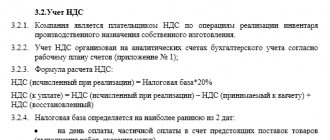Accounting policies: regulatory framework, types, procedure and terms of approval
Federal Law No. 402-FZ “On Accounting” and other regulatory documents in the field of accounting determine that all business entities are required to formulate accounting policies based on their structure and characteristics of their activities.
The only exceptions are organizations engaged in business activities in the credit sector, as well as foreign enterprises operating on the territory of the Russian Federation; they are required to be guided by the regulatory documents defined in their country, however, the established rules must not contradict IFRS.
The concept of “accounting policy” is used both in accounting legislation and in tax legislation and carries a certain meaning that is different from each other. The difference in the scope of application of this term implies differences in the terms for which this regulatory document is approved and in its content. In this connection, the following types are distinguished:
- Accounting policies for accounting purposes;
- Accounting policy for tax accounting purposes;
- Accounting policies for reporting purposes in accordance with IFRS.
The first regulatory document (accounting standard), establishing the rules for the formation of accounting policies at the enterprise, was approved in 1998. Later in 2008, the standard was revised, finalized and today is the official document “Accounting Policy of the Organization” (PBU 1/2008 approved by Order No. 106n dated 10/06/2008).
In total, this PBU has 24 articles (Article 25 has lost force according to Order of the Ministry of Finance of Russia dated April 28, 2017 N 69n).
The content is documented in a special internal document - “Order on Accounting Policies”. This document is drawn up by the chief accountant, and he is responsible for its formation and execution. The order is drawn up at the time of establishment of the enterprise or its reorganization (according to Article 313 of the Tax Code of the Russian Federation, paragraphs 4, 8, 9 PBU 1/2008 within 90 days from the date of state registration). Approval of accounting policies every year is not mandatory, but it is necessary to pay attention to the validity period of this document. For enterprises whose accounting policies do not change for a long period, it is better to leave the end date open. You can correct it in two ways:
- making changes by re-approving in a new edition;
- introducing changes and additions to the current policy by appropriate order.
The order reflects all the main elements of the accounting policy. Elements that require the most detailed consideration and are too voluminous to be reflected in the order are placed in an appendix.
Examples of such applications are:
- Forms of primary documents that do not have a unified form, developed by the organization itself;
- The organizational structure of the financial responsibility center that maintains accounting records at the enterprise, its composition and functional assignment;
- Enterprise document management system, etc.
Conceptual help!
The accounting policy of an enterprise is defined as a set of accounting methods - primary observation, cost measurement, current grouping and final generalization of the facts of economic (statutory) activities (clause 2 of PBU 1/08).
Structure of the accounting policy of a budget organization
The structure of the accounting management system is determined by the institution itself, taking into account the mandatory elements regulated by Law No. 402-FZ on accounting and industry regulations. For example, clause 6 of the Instructions for the Unified Chart of Accounts for government institutions (approved by Order of the Ministry of Finance of the Russian Federation dated December 1, 2010 No. 157n) provides for the following mandatory components of the UP BU:
- a working chart of accounts that meets the required level of information analytics - the Chart of Accounts for accounting of budgetary institutions is taken as a basis (approved by order of the Ministry of Finance of the Russian Federation dated December 16, 2010 No. 174n);
Read about the main sections of the institution's chart of accounts and the composition of budget accounts here.
- accounting algorithms, including methods for assessing property and liabilities;
- procedures aimed at ensuring the safety of the institution’s property (inventory measures, the procedure for organizing internal financial control (internal financial control));
For information about which document any inventory begins, read the article “Order for conducting an inventory - a sample of filling out .
- scheme for recording events after the reporting date;
- “documentary” procedures (primary forms and accounting registers, document flow procedures, detailing the technology for processing accounting information);
You will find a complete set of forms of primary documents, accounting registers and reporting for budgetary institutions in ConsultantPlus. If you do not have access to this legal system, full trial access is available for free.
- other organizational and methodological solutions.
UP BU includes provisions related to accounting and tax accounting. Since these provisions do not always coincide, the accounting policy either consists of two parts (accounting and tax) or is represented by two independent documents. The developed accounting policy will need to be approved by order.
The form of the order for approval of the accounting policy can be downloaded here.
Main stages of accounting policy, goals and factors influencing its formation
The accounting policy is an internal document of the enterprise and the process of its preparation involves two stages:
- Formation (composition, selection and justification);
- Disclosure (publication).
The second stage is applicable only for organizations that, in accordance with the law (or according to the statutory documents), are required to publish financial statements.
Let's take a closer look at the formation stage. This stage includes several stages:
definition of the subject, selection of accounting objects for a given enterprise (the composition of the objects determines the conditions influencing the formation at the second stage);- assessment of factors, their analysis and formation of a list of accounting methods;
- determination of the basic provisions for drawing up accounting policies;
- identification of accounting methods for selected objects;
- approval of a list of methods for maintaining accounting records for a given enterprise;
- documenting.
The goals pursued by an enterprise when drawing up accounting policies at an enterprise boil down to the following:
- documenting the method of maintaining accounting;
- organization of document flow;
- organizing the work of the accounting service, ensuring vertical and horizontal connections;
- determination of the number of control unit elements, etc.
The accounting policy establishes methods of accounting, selected from the list defined by accounting standards, or methods developed by the organization itself, in case of absence for any objects. In any case, the choice of method should be based on common principles, which means:
- use of the selected methods by all structural divisions of the enterprise, for the purpose of comparability of information and the possibility of drawing up consolidated reporting (in terms of branches and representative offices);
- using one method to solve one specific issue. For example, revenue from sales of products for all types of activities should be determined either by shipment or by payment.
Factors influencing the formation of accounting policies:
- organizational and legal status of the enterprise, form of ownership, scale of activity;
- goals for creating an enterprise (strengthening market position, attracting investments, etc.);
- type of activity of the enterprise, its features. Production activities - resources used, technologies), commercial activities (forms of payment, organization of sales and supply), financial activities (relationships with extra-budgetary funds, tax service), management activities (functional structure, reporting system, etc.).
- personnel composition – personnel qualifications;
- external factors: market infrastructure, financial policy, legislation, etc.
Methodological aspects of drawing up accounting policies
When developing UP accounting regarding methodological issues of accounting, it is necessary to take into account the following:
- UP accounting should reflect the peculiarities of the institution’s work on aspects that are not regulated by regulations or on those in respect of which the right of choice is legally granted;
- the application of the accounting algorithms established by the UP BU must be carried out consistently from year to year.
Next, we will dwell on the methodological nuances of accounting accounting in the context of the main accounting objects.
Accounting for non-financial assets
The section of the Accounting Manual dedicated to the accounting of non-financial assets may contain:
- algorithm for determining the useful life of a fixed asset (FA), if its name is not in the classifier;
- the procedure for determining: the current estimated value of the fixed assets (on commission, using an expert assessment), the cost of the liquidated parts of the fixed assets and the depreciation accrued on them;
- scheme for assigning a unique inventory number to the OS;
- features of accounting for individual property objects (library collections, software);
- a list of particularly valuable property by type;
- the procedure for off-balance sheet accounting of property;
- features of accounting for intangible assets;
- nuances of inventory accounting (registration, evaluation, write-off);
- a methodology for separate accounting of expenses when forming the cost of services provided by an institution by type, indicating a list of direct and overhead costs;
- other accounting aspects.
Read about the specifics of fixed assets accounting in budgetary institutions here.
Accounting for financial assets
When developing this section of the UP BU, the following is provided:
- the procedure for accounting for funds on the institution’s personal accounts;
- “cash” algorithms: maintaining a cash book, accounting for monetary documents;
- description of the procedure for issuing funds on account;
- other “monetary” nuances.
For information on what standards to take into account when developing this section of the accounting management system, read the article “Accounting for cash transactions in budgetary institutions (nuances)” .
Accounting for liabilities
The relevant section may include the procedure for accounting for certain types of obligations:
- for paying taxes;
- on social security;
- to raise funds to fulfill obligations;
- on the transfer of assets and liabilities between types of activities.
Read about accounting and methodological aspects of budget obligations here.
Accounting for financial liabilities
Among the important points described in this section of the BU UP are:
- methodology for separate accounting of income by type of activity;
- list of expenses of the current financial year and their accounting system.
Reserves for future expenses
This section of the UP BU describes the nuances of the reserves formed by the institution. For example, the following accounting elements can be provided for the reserve for upcoming vacation pay:
- date of formation of the reserve;
- formula for calculating the monthly percentage of deductions;
- maximum reserve size;
- inventory procedures for reserves;
- scheme for writing off and accruing reserves.
Authorization of expenses
The UP BU reflects:
- methods of accepting obligations (moment of recognition, basis document);
- ways of accepting financial obligations.
Read about what is remarkable about the organization of accounting in a budgetary institution in the article “Accounting in budgetary institutions .







